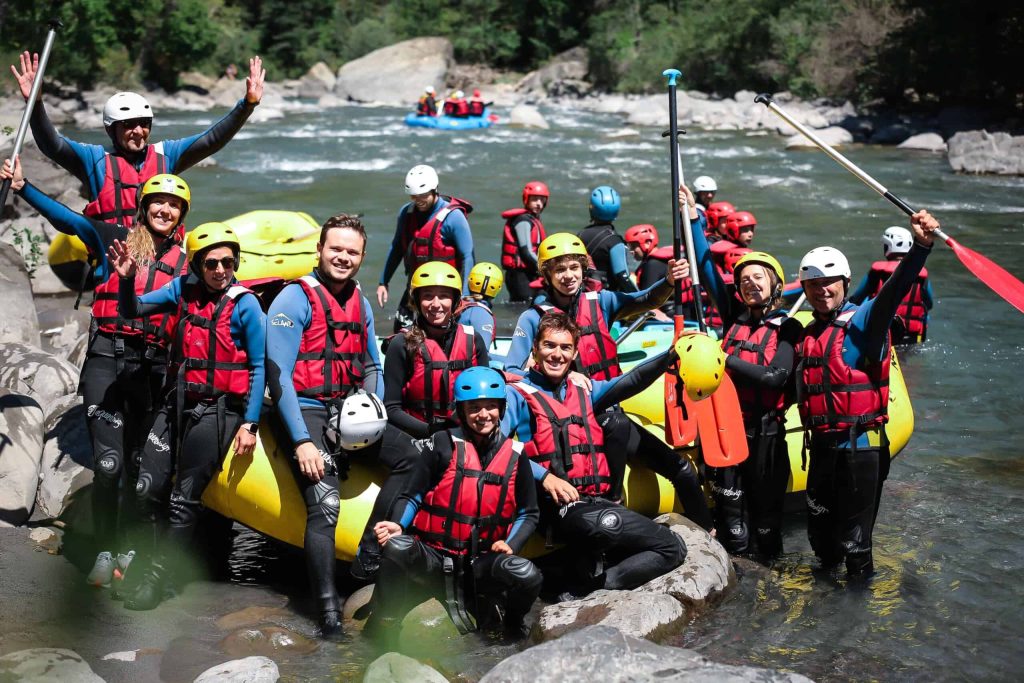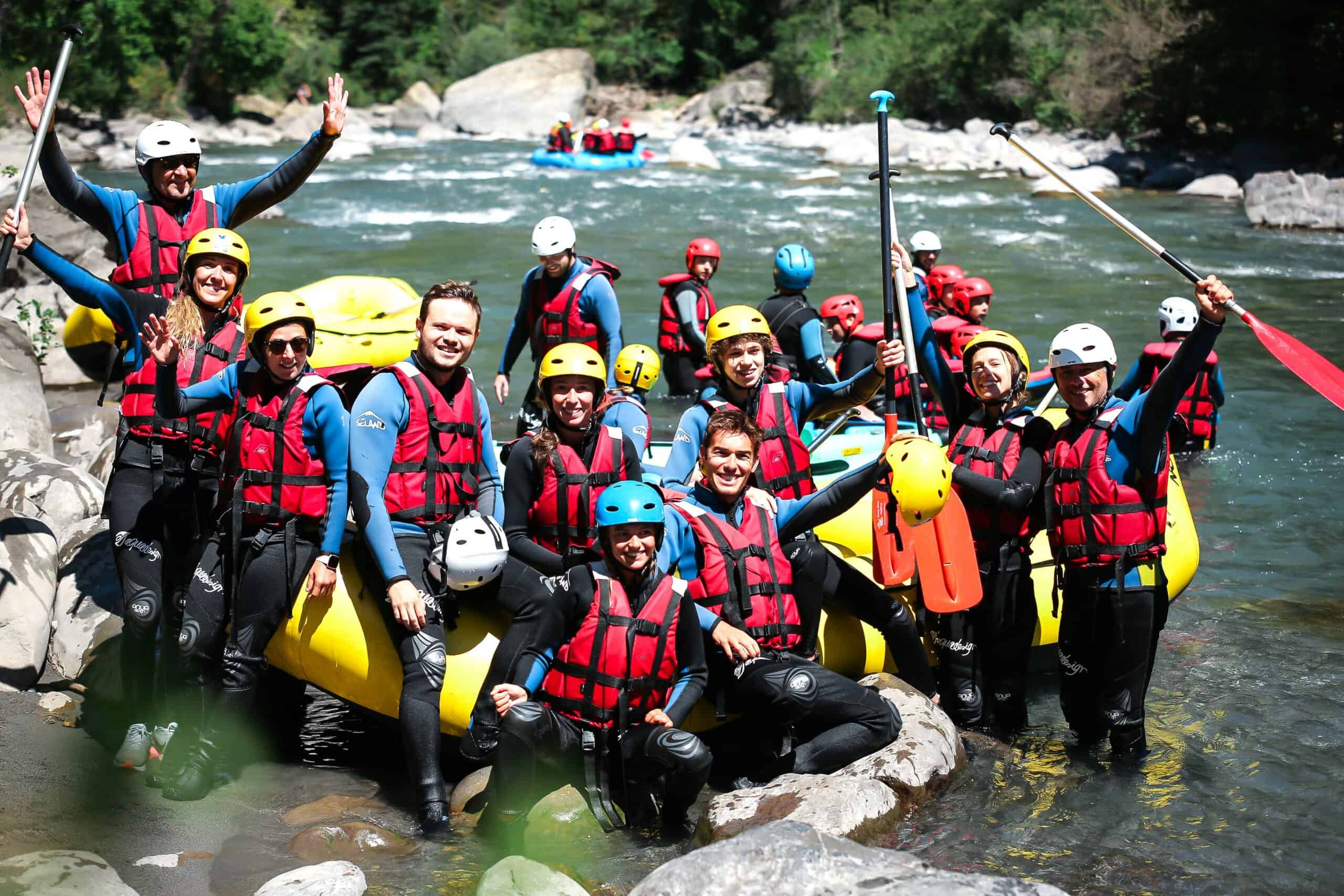Rafting for dummies
You are planning to embark on your first outing rafting and have no idea what equipment you need? No worries! We'll explain everything to you on this page.
Often, most of the equipment needed for rafting will be provided by the company you are rafting with. But we know you, you are the curious type 😉
It is true that if you want to understand the rafting in depth, you need to know some equipment. Some are there for comfort, others for safety, and still others for emergencies. Hang in there, here’s everything you need to know about rafting equipment 🙌

Essential equipment for rafting
So, you are ready to embark on a rafting adventure ? Great ! Now is the time to tell you about the essential equipment you will need for this activity. Of course, most rafting companies provide some of the equipment, but it's important to know what you absolutely must have to ensure a safe and enjoyable experience.
Life jacket
The life jacket is one of the most important pieces of equipment and must be worn at all times during the entire descent. It will allow you to float if you fall into water and stay on the surface. Make sure the lifejacket fits well and does not slip on your body and that it respects the CE standard .
Helmet
The helmet is another essential piece of safety equipment for rafting.
It protects your head from rocks, tree branches and other obstacles you may encounter on your rafting journey. Even if you don't plan to fall in the water, a helmet is essential equipment for your safety.
Okay, okay. But how to put it properly?
It's simple.
Make sure the helmet fits properly and covers your head well.
If the helmet is too loose, it could move in the event of a fall and not protect your head effectively. If the helmet is too tight, it may cause discomfort or headaches. Remember that a properly fitted helmet is the key to effective protection of your head.
Speed is another consideration when it comes to wearing a helmet while rafting. The faster you go, the more dangerous impacts with rocks and other obstacles can be. Even small falls can cause serious head injuries if you are not protected by a quality helmet.
Imagine that you are rafting down a river and you approach a waterfall. Suddenly, the current carries you away faster than expected and you find yourself propelled against a rock at the bottom of the waterfall. Without a quality helmet, you could suffer a serious head injury that could be life-threatening.
The paddle
The paddle is a crucial piece of equipment for rafting because it allows you to steer your boat through the rapids and navigate the water. There are different types of paddles for rafting, each offering unique benefits and features.
- Aluminum paddles are often lighter and stiffer, making them ideal for professional paddlers. They are often made with a double tube, aluminum on the inside and fiber on the outside, to give them more rigidity and save weight.
- Fiberglass paddles are ideal for beginners. They are often made in one piece with an enlarged blade for a powerful attack. Some also feature a curved shaft for more aggressive paddling and more precise control of the craft.
- Carbon fiber paddles are the most expensive. They are suitable for experienced paddlers looking to improve their paddling technique and performance.
If you are a beginner, a paddle that is light and easy to maneuver will probably be best for you. If you are a professional paddler, you may want to consider a stiffer, lighter paddle to improve your performance.
Size-wise, it’s simple.
Most paddlers choose a paddle that hits below the chin, but this can vary depending on your paddling technique and comfort. Also make sure the paddle fits your hand properly and you can hold it comfortably throughout the descent.
The neoprene suit
Finally, the neoprene suit is essential equipment to keep you warm and dry during your descent. It protects your skin against the sun's rays and friction with water. Most wetsuits are made from 3 to 5 mm thick neoprene. Make sure you choose a wetsuit of the right size and thickness based on the water conditions.
Now that you know the essential equipment for rafting, you can focus on the essentials: having fun safely on the water!
Comfort equipment for rafting
In addition to essential safety equipment, there is optional equipment to ensure you have a more comfortable rafting experience. Here are some of the optional equipment you might consider bringing with you:
River shoes
River shoes are useful comfort equipment for rafting. They help protect your feet from rocks and other obstacles in the water, while providing better grip on slippery surfaces.
River shoes are often made with water and abrasion resistant materials for maximum durability. They are also designed to be lightweight and comfortable, so they don't hinder your movement on the water.
River shoes can come in different designs, with features like non-slip soles, breathable materials, and adjustable lacing systems.
If you don't have river shoes, you might consider wearing lightweight athletic shoes with a grippy sole.
However, keep in mind that athletic shoes are not specifically designed for rafting and may not offer the same protection and comfort as dedicated river shoes.
The neoprene top
The neoprene top is useful equipment to keep you warm in cool temperatures. It is also designed to protect your skin from the sun's rays and friction with water. There are different models, but make sure you choose the one that fits your body well and does not restrict your movements.
Neoprene gloves
Neoprene gloves can be useful if your hands are sensitive to the cold. They also protect your hands from friction with water and rocks. If you plan to bring gloves, make sure they are good quality and fit your hands well.
Sun cream
Finally, sunscreen is an important sun protection equipment to prevent sunburn and protect your skin from harmful UV rays. Opt for a water-resistant sunscreen with a high sun protection factor for maximum protection.


